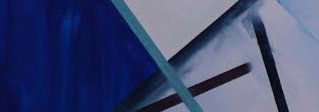

Loitering with Intent is my first solo exhibition of paintings at Haw Contemporary, and will occupy all three of the ground floor galleries.
In the first gallery the work plays with structure and the shifting relationship between two-dimensional forms and their translation into shallow three-dimensional structures. The group of four works includes two earlier fabric constructions (which I see as seminal to much of the work that has followed) that act as surrogates for painting. One of the fabric constructions has a shelf-like attachment at the base, with fabric-covered objects spilling from it, clustering at your feet. It presents a platform or a stage for viewing and we become participants in the event. As the color and the compositions engage us visually and intellectually, the extended planes of the constructions prod our bodies, reminding us of how we locate ourselves.
Since the making of the fabric constructions, many of my concerns in making paintings relate to the notion of architecture, a sense of armature, a sense of place.
In the second gallery, the work has more of a linear scaffolding that both articulates the space and disrupts it. The geometry of the forms and the interplay of the scaffolding activate the movements within the paintings, much like we navigate the architectural space of buildings. In architecture we are directed by portals, passageways and destinations. In the paintings there are never fixed destinations; color and surface can lead you astray, directing you into unknown territory.
The collection of paintings in this gallery suggest a collective consciousness, where one painting acts as the precursor for the next. Although there is a shared topic of conversation amongst the group, there are differing discussions taking place; some are quiet and others more aggressive. These paintings have many more vacant spaces, where the surface is barely touched by color. Are these spaces pauses between incidents? Do they act as places to rest, or are they footprints waiting to be built upon? The white spaces relate to the notion of displacement, the removing of what existed before as in the urban core or the displacing of virgin land with new dwellings. In the paintings some of the white space is untouched primed canvas. Some is white space recovered, reflecting their history of change.
In the large gallery the paintings have a different presence. There is a thinness and transparency to the paint which seems to suggest an atmosphere or a sense of light being transmitted. The surface of paint is more open, more playful, the result more uncertain. Like the layered veils of fabric in the first gallery, here the veils of color reveal a process of editing, of wiping away, of excavating. The thinner paint skins reveal various marks or subtle gestures, a sense of touch becomes more evident in the paintings. The structure gets pared down and hopefully more assured and to the point. The paintings have a sparseness; internally, they refer to one set of incidents rather than many. They have a slower read.
Throughout the exhibition color is a primary concern and focus. It’s a fascination I have had for many years, with its changing identity through different surfaces and processes. I think my ongoing curiosity about color was further heightened after moving into my new studio, where the carefully balanced studio lighting has provided the opportunity to examine it more intently.